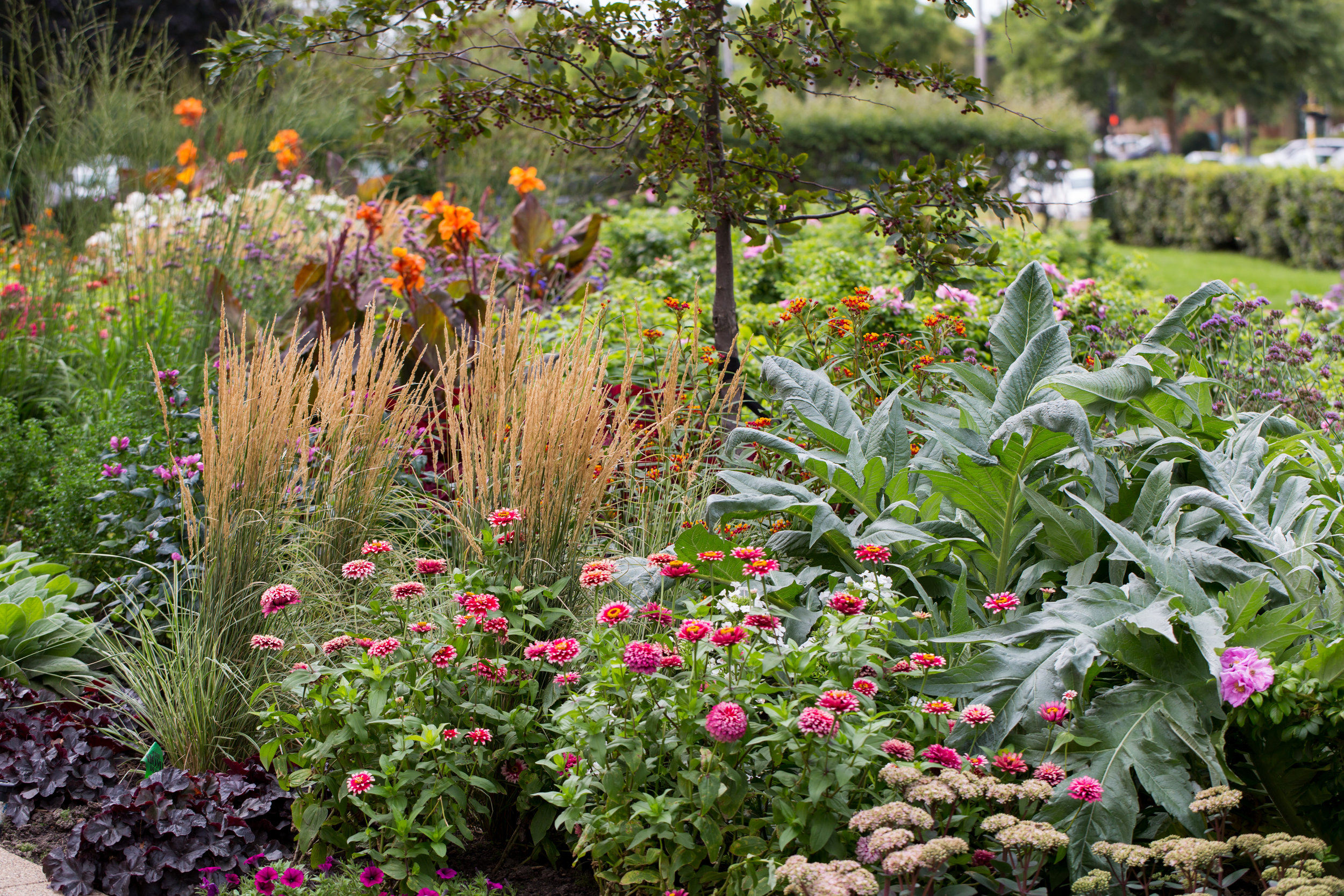Tips for Season-Long Annual Plant Beauty
We’re finally in the full swing of summer annuals season! Those long-sought-after blooms and leaves are starting to thrive in our pots and windowboxes. Annual plants start the summer looking fresh and full of potential, but they can decline quickly if we don’t care for them correctly. This is usually because annual plants experience very different conditions in home gardens than they do while growing in the greenhouses where they’re raised. Allow our Phillips Garden maintenance team to recommend some gardening practices that will keep your annuals looking gorgeous throughout the entire growing season.
A successful annual planting
Watering
Consistent watering is the most important factor in keeping your plants happy throughout the season. One common mistake is letting plants dry out to the point of wilting. Wilting means a plant is in distress, and it can cause long-term damage. To prevent this damage, water your annuals before the soil dries out completely. Daily watering is sometimes necessary in hot and sunny locations, especially in the heat and drought of mid-summer. If you find yourself watering multiple times a day, consider replanting in a larger container that will not dry out so quickly.
Too dry! Don't let your annuals wilt.
Another common mistake is overwatering, or not letting the soil dry out between waterings. Plant roots need oxygen, and too much water fills in the air pockets around the roots, essentially drowning the plant. Planting in a well-drained potting mix keeps roots from becoming frequently water-logged. Use a soil mix specifically labeled as a potting medium instead of heavy garden soil or black dirt.
Too much water!? Too little water!? How do you know when or when not to water? That old trick of sticking your finger into the pot is tried and true. Water your plants thoroughly when the top two inches of soil are dry to the touch.
Pinching and deadheading
Annual plants that tend to get long and leggy, like petunias, or tall and spindly, like salvias, benefit from pinching early in the season. This means that you remove the tip of the main stem, cutting it back to the next set of leaves. Pinching back the terminal bud encourages your plants to be bushier and produce more flowers.
Pinching salvias makes them strong, bushy, and floriferous!
You can also cut plants back when they get overgrown and out of control. Most annuals benefit from this treatment in mid to late summer. Cut about half of the stems back by two-thirds (and cut the other half back similarly in a few weeks), which will cause the plant to send out a new flush of growth.
Cutting back scaveola promotes lush new growth.
For many annual plants, removing the finished flowers (deadheading) is essential to season-long flowering. Otherwise, these annuals put their energy into producing seeds instead of flowers. Removing faded blooms by cutting them off just at the base of the flower (before they can start setting seeds) tells the plant to keep sending out new flower buds. Some annuals are “self-cleaning” and don’t need to be deadheaded, but zinnias, geraniums and dahlias (among others) need trimming to stay in constant bloom.
Feeding
Annual plants are heavy feeders, so regular fertilizing throughout the growing season keeps them looking their best. A slow-release organic 5-5-5 fertilizer applied twice a season should do the job! Unless your annuals are exhibiting signs of nutrient deficiencies, they will be fine with low amounts of nitrogen, phosphorus, and potassium.
Light
Along with all of the above factors, each plant has unique light requirements that keep it healthy and looking its best. When choosing plants for your containers and windowboxes, be careful to assess the light conditions where you are going to plant them. Full sun means at least six hours of direct sun. Most full sun plants need that amount or more to be good flower producers. Part sun/ part shade means three to six hours of direct sun, and full shade plants do best with little or no direct sun. Group plants with the same light requirements together.
These tropical annuals love full sun -- canna lilies, brugmansia, lantana, etc.
Pests and Diseases
Watch carefully for pests and catch them before they do irreversible damage. For common pests like aphids and whiteflies, the first line of attack is a blast of cold water with a hose, maybe multiple times, with the goal of physically removing the insects from the plant. As a second option, try an insecticidal soap or horticultural oil sprayed directly on the pests. Stay away from conventional pesticides, as they can also kill any beneficial insects that are nearby.
Aphids love the tender new growth on annual butterfly weed.
Fungal diseases can devastate annual plantings very quickly. Powdery mildew is a common fungal disease of mid-summer that gets worse during periods of extreme humidity. Check your annuals for a white “powdery” substance that covers the leaves and stems. As soon as you confirm the disease’s presence, use a fungicide to prevent its spread. The key to controlling fungi is preventing it rather than curing it. Fungicide sprayed on healthy leaves will protect the plant from further infection.
With a little planning and care, your containers can thrive throughout the summer season and well into the fall. If you’re struggling to keep your annuals happy, check in with our knowledgeable gardening staff. Phillips Garden wants to see you succeed, so you can love gardening as much as we do!
Healthy annuals are beautiful all summer long!!







